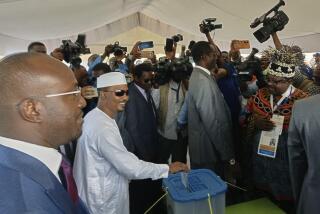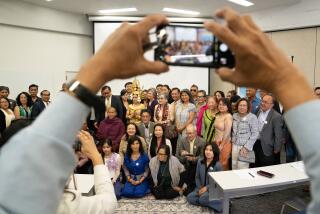Despite Threats, Voters Flock to Cambodia Polls
- Share via
PHNOM PENH, Cambodia — With a threat by Khmer Rouge guerrillas to disrupt the election largely unrealized, Cambodians thronged to the polls for a second day of voting today amid initial signs of an unexpectedly heavy and enthusiastic turnout.
Only three minor incidents were reported during the first day of voting Sunday, confounding earlier fears that intimidation and violence might keep voters away.
The large turnout was additionally surprising because the annual monsoon rains drenched the country Sunday morning, but the downpour was seen as a good omen in this rice-growing nation and reinforced an atmosphere of holiday festivity.
“Seeing the long lines and the enthusiasm of the population confirms that confidence in the Cambodian people was well placed,” said Eric Falt, a U.N. spokesman.
Falt said that between 1.5 million and 2 million of Cambodia’s 4.6 million registered voters cast their ballots Sunday, the first of six days of voting for a new Parliament. Because of fears of violence, U.N. officials had said earlier that they would be happy with an eventual turnout of just over 50%.
The election is the culmination of a $2.6-billion U.N. effort to end decades of civil war here and return the country to democratic rule. A total of 20 political parties are taking part in the election for a new 120-member Parliament, which will write a new constitution and choose a new government.
The Khmer Rouge, blamed for the deaths of more than 1 million Cambodians during its brutal reign in the 1970s, signed the October, 1991, peace agreement that led to these elections. But the group balked at surrendering its arms last June and had vowed to disrupt the voting.
“There’s a recognition that Cambodians want to vote, so anybody who is saying there is a popular rejection of the vote by Cambodians has probably come to an understanding that it isn’t so, that Cambodians really do want the election,” Lt. Gen. John Sanderson, an Australian army officer who commands the U.N. military contingent in Cambodia, said of the Khmer Rouge threat.
A crowd of hundreds of people braved the rain to stand in a huge crush of voters waiting to cast ballots at Phnom Penh’s Olympic Stadium during the first day of voting.
Perhaps an early indicator of the trend in the voting came when Prince Norodom Ranariddh, leader of the royalist FUNCINPEC party, was cheered wildly by the waiting throng. At the same time, Chea Sim, head of the ruling Phnom Penh government’s Cambodia People’s Party, entered the polling station without the sound of any applause.
Ranariddh, who returned from exile to lead his party in the election, said the Cambodian people crave democracy and that all the parties should respect the will of the people.
In a possible explanation for the Khmer Rouge’s failure to disrupt the polls, Ranariddh said the group’s behavior would be taken into consideration when efforts are made to form a government after the election is over.
Ranariddh confirmed that if his party wins, he will turn over “full state powers” to his father, Prince Norodom Sihanouk, Cambodia’s nominal head of state, who was ousted from power in a 1970 coup.
“Let me in, let me in--I want to vote for his royal highness!” shouted an elderly woman carried along by the crowd.
Sihanouk has said he hopes to form a government of national reconciliation that would include members of all parties, including the Khmer Rouge--even though the Khmer Rouge boycotted the election. The Khmer Rouge issued statements last week indicating that it supports such an approach.
The Phnom Penh administration headed by Prime Minister Hun Sen countered that his government, if elected, would fight the Khmer Rouge to the finish.
Despite the absence of democratic institutions for decades, the voting process proceeded smoothly, and most voters jealously guarded the secret of their ballot choices.
“I’m happy to see democracy come back to my country,” said a 28-year-old Cambodian police sergeant, Chhin Sokha. “Because of this election, life will be changed for the better. But I think the fighting can still go on.”
The only incident that appeared to have disrupted voting took place about 20 miles from the capital of Kampot province, when soldiers believed to be Khmer Rouge guerrillas fired at a ballot box. Voting was halted for 30 minutes.
While the voting appeared to be unaffected by reports of intimidation, the United Nations released details of political violence from March 1 until the end of the campaign last week.
Dennis McNamara, head of the U.N. human rights component here, said there were 200 deaths, 338 injuries and 114 abductions. Of these, he said, responsibility could be attributed to the Phnom Penh regime in 15 of the deaths and nine of the injuries, while the Khmer Rouge was responsible for 131 deaths, 250 injuries and 53 abductions. He said 20 attacks on political parties could also be attributed to the Phnom Penh regime.
BACKGROUND
Cambodia became involved in the Vietnam War after Prince Norodom Sihanouk was toppled in a 1970 coup. In 1975, as the Vietnam War was ending, the Communist Khmer Rouge defeated the U.S.-backed Lon Nol government. The Khmer Rouge was ousted by Vietnamese forces in 1979, sparking a civil war. The United Nations has been supervising Cambodia’s administration under the terms of a 1991 peace accord. The assembly elected this week will draw up a constitution for forming a new government. The Vietnamese-installed government, led by Prime Minister Hun Sen, controls about 80% of the country. Most of rest is held by the Khmer Rouge, believed still led by the mysterious Pol Pot. The Khmer People’s National Liberation Front, led by former Premier Son Sann, and non-Communist rebels loyal to Prince Norodom Ranariddh, Sihanouk’s son, hold pockets of territory.
More to Read
Sign up for Essential California
The most important California stories and recommendations in your inbox every morning.
You may occasionally receive promotional content from the Los Angeles Times.










